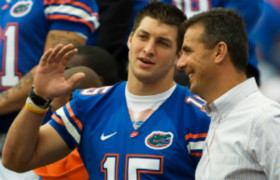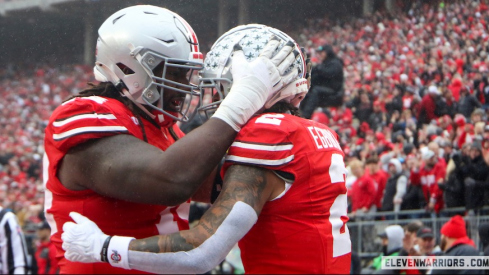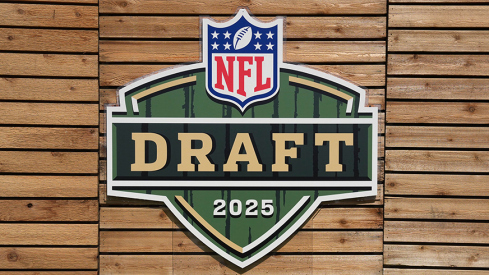 Not flashy, but certainly consistent.
Not flashy, but certainly consistent. As I alluded to last week, this week's stat session compares Tressel and Meyer's offenses and defenses to see how each found consistent success between 2005-2010. I again build off of the S&P+ statistics work, though this week will feature 100% fewer regression tables compared to last week.
In case you missed last week's analysis, the S&P+ ranking system is comprised of three measures of individual play success: individual play success (progress at gaining a first down), explosiveness, and a measure designed to reward tougher schedules.
Last week's analysis looked at the 2011 football season and found that better offenses were highly correlated with both final AP ranking and overall wins. Several of you mentioned that you'd like to see trends and comparisons over time, so this is definitely the post for you.
The common understanding is that Tressel's football success has always been due to the Silver Bullets rather than the Walrus/Tresselball offenses. Ohio State, save for the beautiful Troy and Ginn offenses, never really put points on the board like this. Meyer, on the other hand, has been known for his innovative, Tebow-led spread offenses.
I thought it might be helpful to understand how each patriarch managed to win so much and so consistently in order to maybe see what's in store for us next year.
TRESSEL'S OFFENSES AND DEFENSES
A few notes before beginning: this table represents Tress's offensive and defensive S&P+ rankings from the beginning of Football Outsiders' records in 2005 until his premature departure from the university. The number in parentheses represents the offense's or defense's final ranking. The "SOS" column is not a measure of the number of cries for help, but the strength of schedule power score relative ranking.
| Year | Offense | Defense | SoS | Record |
|---|---|---|---|---|
| 2005 | 122.9 (9) | 141.9 (2) | 8 | 10-2 |
| 2006 | 132.9 (5) | 130.7 (7) | 7 | 12-1 |
| 2007 | 109.6 (35) | 147.1 (1) | 9 | 11-2 |
| 2008 | 114.7 (22) | 127.2 (7) | 9 | 10-3 |
| 2009 | 111.2 (33) | 138.4 (7) | 24 | 11-2 |
| 2010 | 122.5 (12) | 135.6 (4) | 18 | 12-1 |
A couple of things stand out from this table. Fittingly for The Senator, everything about Tressel's tenure was remarkably consistent. During this time period, his strength of schedule hovered in the top ten until the '09 season, he won ten to twelve games every year, and his offenses were at least in the top 35.
As we might expect, Tressel's teams' real strength were their insane defenses. Even with a top-ten strength of schedule rating nearly every year, Tressel's defenses managed all top-seven finishes, with three top-four defenses. The standard deviation across the six years is only by ~7 points, meaning that all of Tress's defenses were largely close to the defense S&P+ ranking's mean of 136.8.
In contrast, his offenses only cracked the top ten twice with Troy Smith at the helm, though Pryor's 2010 campaign wasn't too shabby at twelfth in the nation. Though not at the same level as his defenses, his offenses were similarly stable, with a standard deviation of ~9 points and mean of 119 for the offensive S&P+ ranking.
 We'll need Meyer and Brax to be like this
We'll need Meyer and Brax to be like thisLooking at the means and standard deviations of Tressel's offenses and defenses paints a pretty clear picture. Tressel won ten game per year largely on the back of his stellar defenses. His defenses were more consistent, and limited both explosive and overall play success, even when controlling for strength of schedule.
MEYER'S OFFENSES AND DEFENSES At Florida
At first glance, it seems like Meyer's tenure at Florida is far more streaky than Tressel's rock of a program. The offense ranges from first in 2007 all the way to 53rd with Brantley in 2010, while the defense ranges from third (twice, in '06 and '09) to an ugly 62nd in 2007. His offenses average 126.9 on the S&P+ (about 8 points higher than Tressel's) while his defenses come in at 123.4 (about 13 points lower than Tressel's).
However, it's key that Meyer's offenses and defenses have significantly more S&P+ variation than Tressel's offenses and defenses. Meyer's offenses have a standard deviation of 18.9 (~9 for Tress) and his defenses a 15.6 (~7)! This is significant - Meyer's offenses and defenses are always pretty good, but sometimes they are incredible.
| Year | Offense | Defense | Sos | Record |
|---|---|---|---|---|
| 2005 | 112.7 (28) | 116.5 (20) | 18 | 9-3 |
| 2006 | 120.9 (17) | 136.3 (3) | 2 | 13-1 |
| 2007 | 151.1 (1) | 99.6 (62) | 14 | 9-4 |
| 2008 | 146.4 (2) | 131.3 (4) | 2 | 13-1 |
| 2009 | 128 (4) | 141.1 (3) | 2 | 13-1 |
| 2010 | 102.5 (53) | 115.5 (24) | 27 | 8-5 |
The real takeaway here, however, is that Meyer's teams were at their best - 13-1 national champions kind of best - when Meyer's defenses are in the top-5. For instance, Meyer's offense was only 17th but his defense 3rd in the country in 2006. I don't even want to mention Ohio State's contact with Meyer's defense that year, though I think Troy still has nightmares about it (paralipsis, amiright?).
While we're only looking at seven data points here, there are absolutely the beginnings of a correlation between strong defense and success. Meyer's offenses are almost always top notch - but when he has a lights-out defense it seems like he's destined to go 13-1.
If I had to guess, there is more variation Meyer's offensive S&P+ scores because of the sheer difference between Meyer's Tebow, Brantley, and Leak offenses. You can argue that there's a talent difference, an offensive system mismatch, or that Meyer was just looking to return to Ohio in 2010, but there's no doubting that Meyer's offense really thrives when he has his quarterback. The good news for Buckeye fans is that Braxton Miller is his quarterback.
This analysis is important for our expectations as Buckeye fans. Under Tressel we were blessed with consistently good, often great teams. Under Meyer, if trends continue, we might expect the odd off year (9-4, 8-5), in between years of 13-1, 14-0, national championship type seasons. Though we certainly don't have enough data to generalize, set your expectations for the Meyer regime accordingly.
While it is too early to say whether Meyer will indeed have the same trends continue like he had at UF (and to the extent we can create these two as different archetypes), do you prefer Tresselian consistency or Meyer's sometimes unrivaled greatness?
Hopefully we won't have to choose.

